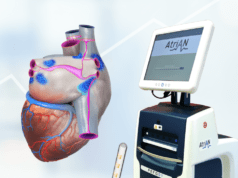The first health economics data from GARFIELD-AF (Global anticoagulant registry in the field–atrial fibrillation) was presented at the European Society of Cardiology (ESC) congress (26–30 August, Barcelona, Spain). These data demonstrate that atrial fibrillation imposes a high financial, economic and human burden on societies across Europe and that there is significant geographical variation in the amount and type of health services used by patients across the world.
In a poster presentation entitled “The burden of atrial fibrillation in the more populated European countries: perspectives from the GARFIELD-AF registry”, data were presented on patients with atrial fibrillation enrolled in France, Germany, Italy, Spain and the UK during 2010–2015. These patients generated a total of 8,574 person-years of observation. Large variations among the five countries were seen, with higher costs per patient per year in the UK (£2,857.3) and Germany (€2,504.1) than in the other countries. Direct costs in each country also differed in the type of costs, with outpatient care as a proportion of the total cost ranging from 9.4% in Italy to 25.1% in Spain. Expenditure for hospital admissions also varied, from 63.9% of the total cost in Spain to 83.7% of the total cost in Italy.
The authors concluded that the great variations observed in the cost for drug treatment can probably be ascribed to different combinations of treatment. Additionally, based on population dynamics, the current financial, economic and human burden of atrial fibrillation is likely to grow in the future. Furthermore, premature mortality substantially adds to the already considerable direct cost of the disease.
In a second health economics poster entitled “Global healthcare resource use in 39,670 patients with AF: perspectives from GARFIELD-AF”, data from patients with atrial fibrillation in 35 countries were analysed. Enrolled patients together generated 30,117 person-years of observation (Asia 7,521; Europe 18,358; Latin America 2,630; North America 780; rest of the world 827).
A total of 402.3 medical contacts per 100 person-years were documented overall, corresponding to an average of more than medical contacts (any type) per patient per year. North America and Europe showed higher healthcare resource utilisation (HCRU) (544 and 432 medical contacts per 100 person-years, respectively) than Asia and Latin America (344 and 360 medical contacts per 100 person-years, respectively).
Of the vast amount of healthcare resource used worldwide, there were significant geographical variations in the amount and type of health services used by patients which, the authors concluded, were potentially associated with the actual availability of services and different models of care organisation in the 35 countries.
The lead author of the two posters, Lorenzo G Mantovani (University of Milan Bicocca, Monza, Italy, comments: “The variability observed in cost items among the five European countries is mostly likely driven by healthcare reimbursement practices and not by inherent differences in patients’ status or type of treatment. Improving outcomes in younger patients would have a great impact in terms of burden to societies.”
He continued: “Furthermore, in terms of HCRU, the next step is to link clinical outcomes of patients with AF among different regions in order to understand the cost-effectiveness of different patient management strategies and to identify the most beneficial approach.”












